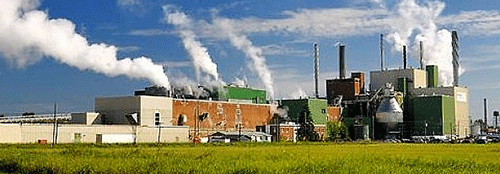 |
||||||||
| February 17, 2014 | ||||||||
| A perforated Uhle box cover proves a success at Propapier PM 2 |  |
|||||||
| · www.tappi.org · Subscribe to Ahead of the Curve · Newsletters · Ahead of the Curve archived issues · Contact the Editor |
Producing heat and electricity together is an energy winner Sometimes what’s old becomes new again, and cogeneration, which is more than 130 years old, is gathering momentum across the world.
“Combined heat and power (CHP), also known as cogeneration, is the simultaneous production of electricity and heat from a single fuel source, such as natural gas, biomass, biogas, coal, waste heat, or oil,” reports the United States Environmental Protection Agency (EPA). Cogeneration was likely first introduced by Thomas Edison in 1882.
During the past decade, the Energy Department has been working to grow the CHP market. Between 2009 and 2012, the partnerships have provided technical support to more than 440 CHP projects—helping U.S. manufacturers, businesses, hospitals and universities understand how CHP can improve their bottom lines, lower energy bills and help protect air and water.
America’s installed capacity is about 82 GW of CHP at more than 4,100 industrial and commercial facilities. President Obama seeks to increase the number of plants in the U.S. by 50 per cent by 2020.
In Canada, cogeneration represents about seven per cent of the naturally produced electricity generation, with Alberta and Ontario boasting many large industrial cogeneration facilities which receive government grants and subsidies.
Our company, Fortress Paper, has made a significant investment in cogeneration at our Fortress Specialty Cellulose Mill in Thurso, Que., where we have expanded into the renewable energy generation sector with the construction of a cogeneration facility and are upgrading the on-site cogeneration facility to produce up to 25 megawatts of green energy. We also entered into an energy supply agreement with Hydro Québec to provide green power to the grid during a 15-year term.
Beyond North America, other continents have been touched by the energy-efficient CHPs. Not confined to industrial and manufacturing sectors, cogeneration facilities can be found in schools, apartment complexes, hotels, nursing homes, colleges and even breweries. In Islamabad, Pakistan, the government is now allowing cogeneration producers to supply electricity directly to industrial consumers including sugar mills. In the Caribbean, Red Stripe brewery seeks to cut electricity costs by as much as 50 per cent and lower its carbon footprint with its new cogeneration plant.
Tuas Power, one of Singapore’s leading power generation companies and provider of energy solutions, started up its latest 406-megawatt gas-fired cogeneration plant. Macquarie University is the first cogeneration system in Australia to use combined power, heat and cooling with chilled water storage.
More than 11 per cent of the European Union’s electricity is produced using cogeneration, with Denmark, the Netherlands and Finland leading the charge. Cogeneration saves Europe around 200 million tonnes of CO2 gas emissions annually. European governments turn to organizations such as the Belgium-based COGEN Europe, whose primary goal is to "work toward the wider use of cogeneration in Europe for a sustainable energy future.”
COGEN research indicates that at least 25 per cent of electricity production could come from cogeneration in the next 20 years. Organizations seeking to establish energy-efficient CHP systems can seek guidance from the World Alliance for Decentralized Energy (WADE).
The continuing evolution to CHP systems globally requires the assistance of governments to lay down regulatory foundations and the establishment of training, safety and performance standards.
Canada’s Centre for Energy reports that “cogeneration is higher in energy efficiency than conventional thermal generation because it reuses heat. Energy that would otherwise be wasted is put to some useful work. Because of its efficient use of energy, cogeneration is more economic and environmentally attractive than conventional fossil fuel power plants. Cogeneration can be located close to electricity consumers, thereby reducing transmission line losses. It accounts for well over half of the new power plant capacity built in North America in the last decade.”
As unpredictable acts of extreme nature occur, CHP systems can play a life-saving role in keeping hospitals running when the electricity grid goes down. As CHP systems can tap into a wide array of fuels to operate, there are few restrictions on where they can be installed.
If your organization is deciding whether to move to cogeneration, visit the EPA’s "Is My Facility a Good Candidate for CHP?" online assessment tool to find out if your business may be a good candidate.
Chadwick Wasilenkoff is Chairman, Chief Executive and founder of Fortress Paper.
© Copyright The Vancouver Sun
Now that you
are Ahead of the Curve, stay there by joining TAPPI. |
|||||||
 |
||||||||



